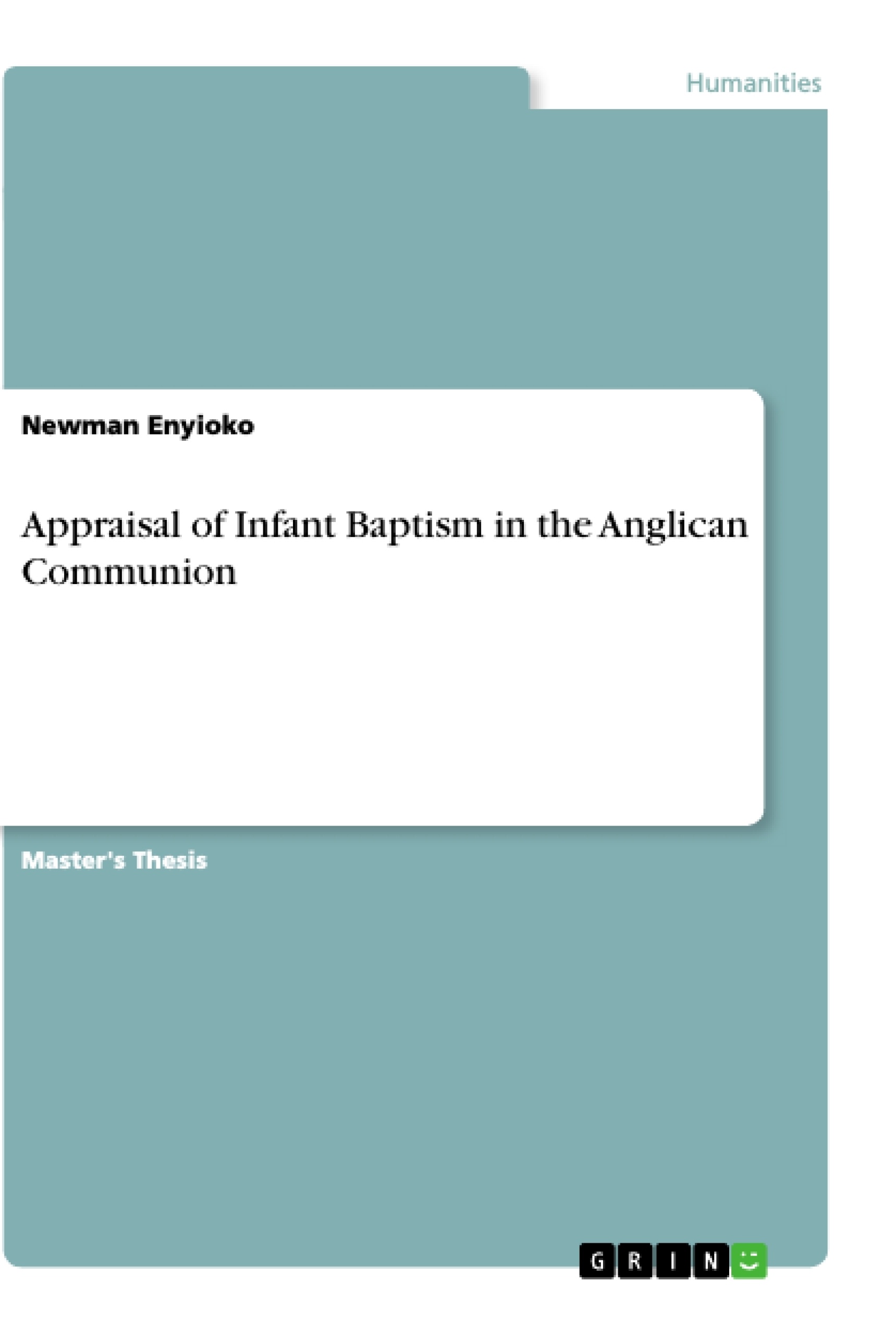This study is about a paradoxical appraisal of infant baptism in the Anglican Communion as a response to the mission and doctrinal challenges of baptism controversy in the Christian domain. Given the situation in the background, it is opined in this study that the Anglican theology of baptism needs to be appraised critically in line with its mission. The practice of infant baptism in Anglican Communion is being misunderstood doctrinally by some other Pentecostal denominations that insist on adult baptism of immersion mode. This misunderstanding of baptism in matters of its significance, function, efficacy, method and the adequacy of the outward mode has made this study very imperative. In other words, the lack of consistent knowledge and teaching about infant baptism seems to be the main factor that enables the baptism theology to have a great influence on the infant baptism debate in Nigeria. That is why this study will investigate the better understanding of the Scriptural significance and mode of infant baptism and survey the Anglican theology of baptism in order to respond to its doctrinal challenges in the Nigeria Christian environment.
Inhaltsverzeichnis (Table of Contents)
- CHAPTER ONE INTRODUCTION
- 1.I Background of the Study
- 1.2 Statement of the Problem
- 1.3 Research Questions
- 1.4 Purpose of the Study
- 1.5 Methodology
- 1.6 Scope of the Study
- 1.7 Significance of the Study
- 1.8 Organization of the Study
- 1.9 Definition of Terms
- CHAPTER TWO REVIEW OF RELATED LITERATURE
- 2.1 Theoretical Foundation
- 2.1.2 Initiatory Theory
- 2.1.3 Leadership Successional Theory
- 2.1.3 Expectancy Theory
- 2.2 Baptism and Church History
- 2.2.1 Baptism
- 2.2.2 Church History
- 2.3 Significance of Baptism
- 2.3.1 Baptism as Means of Grace
- 2.3.2 Baptism as Initiation into the Church
- 2.3.3 Baptism as Remission of Sin
- 2.3.4 Baptism as Participation in the Death and Resurrection of Jesus Christ
- 2.3.5 Baptism as Regeneration
- 2.3.6 Baptism as the Gift of the Holy Spirit
- 2.3.7 Baptism Eschatological Dimension
- 2.4 Conceptual Framework
- 2.4.1 Paradoxical Exposition
- 2.4.2 Concept of Infant Baptism
- 2.4.3 Historical Development of Infant Baptism
- 2.4.4 Reasons for Infant Baptism
- 2.5 Empirical Review
- CHAPTER THREE CONCEPT OF CHRISTIAN BAPTISM
- 3.1 Meaning
- 3.2 Baptism in the Scripture
- 3.3 Types of Baptism
- 3.3.1 Water baptism
- 3.3.2 Baptism is a figure of salvation in Christ (1Pe 3:21)
- 3.3.3 Baptism by the Holy Spirit
- 3.3.4 Baptism with the Holy Ghost
- 3.3.5 Baptism of Christ's suffering
- 3.3.6 Baptism with fire
- 3.4 Mode
- 3.5 Candidates
- CHAPTER FOUR INFANT BAPTISM IN THE ANGLICAN COMMUNION
- 4.1 What is the Anglican communion
- 4.2 Doctrines of The Anglican Communion
- 4.3 Baptism in the Anglican communion
- 4.4 Anglican Beliefs and Practices of Infant Baptism
- 4.5 Arguments in favour of Infant Baptism
- 4.6 Arguments against Infant Baptism
- 4.7 The Paradoxes of Infant Baptism
- 4.8 Appraisal
Zielsetzung und Themenschwerpunkte (Objectives and Key Themes)
This study aims to provide a paradoxical appraisal of infant baptism within the Anglican Communion, addressing the mission and doctrinal challenges surrounding baptism in the Christian world. The study explores the historical development, scriptural basis, and theological arguments for and against infant baptism.
- The significance of baptism in Christian theology
- Historical development and controversies surrounding infant baptism
- Scriptural interpretations and theological arguments for and against infant baptism
- The Anglican Communion's theological perspective on infant baptism
- The practical implications and challenges of infant baptism in contemporary Christianity
Zusammenfassung der Kapitel (Chapter Summaries)
Chapter One introduces the concept of baptism and its importance in Christianity, highlighting the debate surrounding infant baptism. It outlines the study's objectives, research questions, and significance. Chapter Two explores the theoretical and historical foundations of baptism, examining its various interpretations and significance within different church traditions. Chapter Three delves into the concept of Christian baptism, examining its meaning, scriptural basis, different types, and modes of administration. Chapter Four focuses on infant baptism within the Anglican Communion, exploring the church's doctrines, practices, and arguments for and against this tradition.
Schlüsselwörter (Keywords)
The main keywords and focus topics of the text include infant baptism, Anglican Communion, baptism theology, scriptural interpretation, historical development, church history, theological arguments, and Christian doctrine.
- Quote paper
- Newman Enyioko (Author), 2020, Appraisal of Infant Baptism in the Anglican Communion, Munich, GRIN Verlag, https://www.grin.com/document/537297



